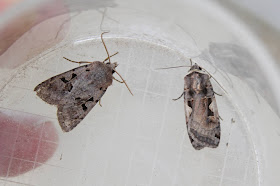1. Bonsai Bank Grid Reference: TR 105 510 GPS: 51.221781, 1.015369
We reached this hidden gem by parking in Penny Pot Lane and then working our way on foot through the woodland with Apple maps until we arrived at the bank which is accessed through a hidden path and an overgrown kissing gate. We spoke to and heard tales of several lost souls wondering round the woods (Denge Woods) looking for the site to no avail so just pray the intermittent 4G is occasionally working or follow the sounds of the chanting and drumming Shaman that we encountered on our visit. The main attraction here is the large colony of Lady's Orchids. We found 150+ Lady Orchids, 8 White Helleborine, Common Twayblades and Common Spotted Orchids. This is also a site for Duke of Burgundy butterfly. We also had Firecrest and Marsh Tits in the woods.
Lady Orchids
Lady Orchid- a variant with paler flowers
The Duke (Duke of Burgundy)
This is not a difficult place to find but impossible to park at so you will need to find a verge somewhere to stack the car and then walk in to find the treasures in the woods. Here we had about 8 Fly Orchids, one Greater Butterfly Orchid, lots of White Helleborines, a few Lady Orchids and Common Twayblades. There are entrances to the nature reserve on both sides of the road, we took the south entrance. Also in the nearby farm and orchards were 4 Turtle Doves singing.
Fly Orchids- this insect mimic (its even got antennae) sends out a pheromone that attracts the solitary wasp Argogorytes mystaceus which pollinates it while trying in vain to mate with it
White Helleborine
The stunning Greater Butterfly Orchid (The two yellow pollonia set wide apart separates it from Lesser Butterfly Orchid)
3. Park Gate Down Grid Reference TR 168 457 GPS HERE
One of the most famous orchid sites in the UK for hosting the largest of only three colonies of the rare Monkey Orchid in the UK. There are three fields, we found most Monkeys were in the second field. We found about 30 Monkey Orchids and also Early Purples (mostly over), Common Spotted, Twayblades and emerging Chalk Fragrant Orchids.
A close up of a little monkey
Monkey Orchids! Stunners!!
Common Twayblade
Chalk Fragrant Orchid- looks like these were just about to come out
Common Spotted Orchid
Park Gate Down
.....and here's a few day flying moths and some tentative identifications that we came across on the chalk grasslands
Lathronympha strigana (?)
White-spotted Sable at Bonsai Bank
Eucosma aspidiscana
Small Purple-barred (fusca)




















































